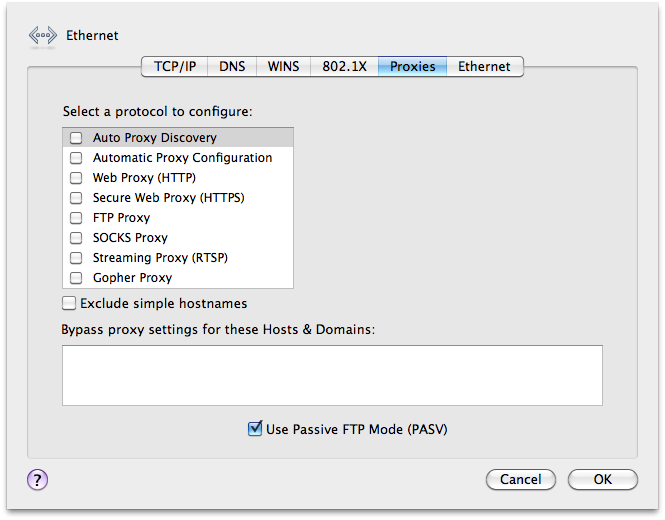

- MAC NETWORK SETTINGS PROXIES USE PASSIVE FTP MODE HOW TO
- MAC NETWORK SETTINGS PROXIES USE PASSIVE FTP MODE FULL
- MAC NETWORK SETTINGS PROXIES USE PASSIVE FTP MODE PASSWORD
- MAC NETWORK SETTINGS PROXIES USE PASSIVE FTP MODE MAC
- MAC NETWORK SETTINGS PROXIES USE PASSIVE FTP MODE WINDOWS
MAC NETWORK SETTINGS PROXIES USE PASSIVE FTP MODE PASSWORD
Most clients offer a save password option so that the user doesn't have to enter their credentials every time.
MAC NETWORK SETTINGS PROXIES USE PASSIVE FTP MODE WINDOWS
The user name entered must include the Windows domain name in the format "DOMAIN\user".

The user details must be supplied by Network Access Controllers within your network, such as your wifi controller.
MAC NETWORK SETTINGS PROXIES USE PASSIVE FTP MODE FULL
The transparent proxy service cannot provide the full functionality of the non-transparent proxy service, so where possible clients should be configured to use the traditional non-transparent proxy service. The non-transparent proxy service provides support for HTTP, HTTPS, FTP and Gopher and is the primary means for clients to contact these services, whilst the transparent proxy will intercept any other HTTP or HTTPS traffic. You can also roll back the changes by clicking on the Revert option.Opendium Web Gateway and UTM provide a traditional non-transparent authenticated HTTP proxy and a transparent proxy. In the last step, click on Apply option at the bottom-right corner of the screen to apply the changes. In case you don’t want to connect the FTP servers after configuring an FTP proxy, enable Use Passive FTP Mode (PSAV) option and then click Ok to save your settings. In order to add you own domain names and addresses, separate each address with a comma. Here, you can add the domain names and addresses for which you don’t want to configure any proxy. This setting is used on local networks and Intranets.īypass Proxy Settings for these Hosts and Domains option allows you to bypass proxies for specified addressed. Other settings allow you to bypass the proxy server while you connect to specific URLs.Įxclude simple hostnames checkbox lets you bypass proxies for simple addresses. Make sure to leave all these checkboxes unchecked if you don’t want to configure a proxy manually. Just enter the address and port number of the proxy for each option you enable. In case you want to configure a proxy manually, you can enable one or more options from Secure Web Proxy (HTTPS), Web Proxy (HTTP), FTP Proxy, Gopher Proxy, and Streaming Proxy (RTSP). Just enter the address of the script in the URL box and your network admin will provide you the address to the proxy configuration script. You can enable Automatic Proxy Configuration option if you want to use automatic proxy configuration script (.PAC file) to configure your proxies. This setting is mainly used on school or business networks. It also allows you to automatically configure the proxy settings.
MAC NETWORK SETTINGS PROXIES USE PASSIVE FTP MODE MAC
You can enable the Auto Proxy Discover checkbox if you want your Mac to decide whether a proxy is needed or not. In the next step, you’ll need to configure a proxy by enabling the protocols from the list under Select a protocol to configure section. Select the Proxies tab in the new window that appears in front of you. Click on the Advanced option in the bottom-right corner of the Networkwindow Just select the network you regularly use Here, you’ll see a list of different networks within your Mac’s range.


You can also launch the app from the Dock. First of all, open the system preferences app on your Mac.
MAC NETWORK SETTINGS PROXIES USE PASSIVE FTP MODE HOW TO
In this tutorial, we’ll guide you through the process in brief: RequirementsĪlso read: How to Enable iTunes Parental Restrictions on Windows and Mac Configure a proxy server on Mac in simple steps That’s why millions of people use the process to access websites restricted in their country. This will allow you to bypass geoblocking and firewall. When you configure a proxy server on your Mac, all the traffic will be routed through it before going to its destination.


 0 kommentar(er)
0 kommentar(er)
